Jennifer Bohnhoff's Blog, page 26
July 4, 2021
Cookies and Quakers
My husband loves cookies. He comes by that love naturally: his mother was a prolific cookie baker. Her Christmas cookie platter brimmed with dozens of different types of cookies. I didn’t get all of her recipes, and even if I did, I couldn’t match my mother-in-law’s cookie baking skills, but I’ve tried, for my husband’s sake. Although he likes many kinds of cookies, these oatmeal and raisin ones are one of his favorites. They are chewy and satisfying and, as cookies go, good for you. I added ground flax to this recipe around 20 years ago, when Hank developed high cholesterol. The doctor said that if he didn’t get his numbers down, he’d have to go on medication. Hank started exercising more, and I added almonds to his lunches, more fruits and veggies to all meals, and flax and oatmeal to many of my recipes. It seemed to do the trick. Hank’s still medication-free and his cholesterol numbers are good.
Hank’s Special Oatmeal Raisin Cookies ¾ cup sugar
¾ cup sugar
¼ cup brown sugar
½ cup butter, softened
½ tsp vanilla
1 egg
½ tsp baking soda
¼ tsp salt
½ tsp apple pie spice (you can use cinnamon if you prefer)
3/4 cup flour
2 tbs ground flax
1 ½ cup quick-cooking oats (you can use regular oats, and your cookies will be a little chewier)
½ cup raisins
½ cup chopped pecans
Heat oven to 375°.
In large bowl, beat sugar, brown sugar and butter until light and fluffy.
Add vanilla and egg and blend well.
Add baking soda, salt, apple pie spice, flour, and flax and blend well.
Stir in oats, raisins and nuts.
Drop by rounded tablespoonfuls, 2” apart, onto greased cookie sheets.
Bake at 375° for 8-10 minutes until golden brown.
Cool 1 minute, then use a spatula to remove from cookie sheets onto a cooling rack.
Famous American Quakers
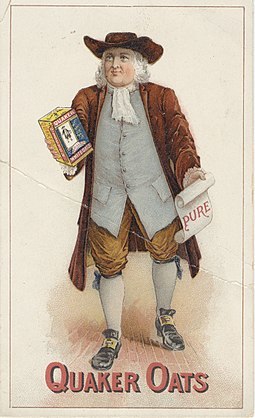 Unless you’re like me and use generic and store brands, the oats you use for these cookies might come from a box that has a picture of a Quaker on it. According to the Quaker Oats Company, this man was America's first registered trademark for a breakfast cereal. Registered on September 4th, 1877, the logo featured a full-length Quaker man holding a scroll with the word "Pure" written across it.
Unless you’re like me and use generic and store brands, the oats you use for these cookies might come from a box that has a picture of a Quaker on it. According to the Quaker Oats Company, this man was America's first registered trademark for a breakfast cereal. Registered on September 4th, 1877, the logo featured a full-length Quaker man holding a scroll with the word "Pure" written across it.
Back in 1909, the company identified this figure as William Penn, the founder of the Commonwealth of Pennsylvania, and called him the "standard bearer of the Quakers and of Quaker Oats." Now, however, the company says that he is not the representation of an actual person, but symbolizes the Quaker virtues of honesty, integrity, purity and strength.
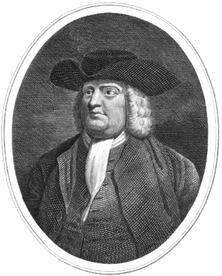 William Penn was born in England on October 14, 1644. King Charles II owed his father, the admiral and politician Sir William Penn, a great deal of money, and in 1681 he handed over a large piece of his North American land holdings along the North Atlantic coast in what is now Pennsylvania and Delaware to cover his debts. The younger Penn, who had been imprisoned in the Tower of London several times for his membership in the Religious Society of Friends, commonly known as Quakers, immediately set sail for America. As soon as he arrived, he convened the first Pennsylvania General Assembly. The democratic principles that he established in the Pennsylvania Frame of Government served as an inspiration for the members of the convention framing the new Constitution of the United States in Philadelphia in 1787.
William Penn was born in England on October 14, 1644. King Charles II owed his father, the admiral and politician Sir William Penn, a great deal of money, and in 1681 he handed over a large piece of his North American land holdings along the North Atlantic coast in what is now Pennsylvania and Delaware to cover his debts. The younger Penn, who had been imprisoned in the Tower of London several times for his membership in the Religious Society of Friends, commonly known as Quakers, immediately set sail for America. As soon as he arrived, he convened the first Pennsylvania General Assembly. The democratic principles that he established in the Pennsylvania Frame of Government served as an inspiration for the members of the convention framing the new Constitution of the United States in Philadelphia in 1787.
Penn’s pacifist theories helped him propose a European Assembly, whose deputies would discuss and peacefully adjudicate issues among the nations, an idea no dissimilar to the European Union in place today.
Penn founded the city of Philadelphia, directing that it be laid out in an easy-to-navigate grid that was very different from the tangled street of his native London. Because Pennsylvania means "Penn's Woods," he named the cross streets after types of trees.
In addition to being an early advocate of democracy and religious freedom, Penn is known for his good relations and successful treaties with the Lenape Native Americans. He died on July 30, 1718.
But although he is the most famous Quaker, William Penn is not the only one. American folk hero Daniel Boone’s family emigrated to the U.S. because they were Quakers and raised their famous son in their beliefs. Cassius Coolidge, the painter who created the famous Dogs Playing Poker was born in upstate New York into a family of abolitionist Quakers. Actor James Dean was raised Quaker and is buried in a Quaker cemetery. President Richard Milhous Nixon’s mother was from an old Quaker family, and he attended a Quaker college in California named Whittier College. Joan Baez's father, Albert, a co-inventor of the X-ray microscope and a well-known physicist, converted to Quakerism when Joan was a child, influencing her anti-war stand. Blues guitarist Bonnie Raitt was also raised in a Quaker family. As far as I know, none of them have ever advocated eating oatmeal. Author Jennifer Bohnhoff was raised Lutheran and eats a lot of oatmeal. She is especially fond of it when it is in cookies. You can read more about her and her books at her website. You can sign up for her newsletter here and be among the first to know about her upcoming books and special offers.
Author Jennifer Bohnhoff was raised Lutheran and eats a lot of oatmeal. She is especially fond of it when it is in cookies. You can read more about her and her books at her website. You can sign up for her newsletter here and be among the first to know about her upcoming books and special offers.
Hank’s Special Oatmeal Raisin Cookies
 ¾ cup sugar
¾ cup sugar¼ cup brown sugar
½ cup butter, softened
½ tsp vanilla
1 egg
½ tsp baking soda
¼ tsp salt
½ tsp apple pie spice (you can use cinnamon if you prefer)
3/4 cup flour
2 tbs ground flax
1 ½ cup quick-cooking oats (you can use regular oats, and your cookies will be a little chewier)
½ cup raisins
½ cup chopped pecans
Heat oven to 375°.
In large bowl, beat sugar, brown sugar and butter until light and fluffy.
Add vanilla and egg and blend well.
Add baking soda, salt, apple pie spice, flour, and flax and blend well.
Stir in oats, raisins and nuts.
Drop by rounded tablespoonfuls, 2” apart, onto greased cookie sheets.
Bake at 375° for 8-10 minutes until golden brown.
Cool 1 minute, then use a spatula to remove from cookie sheets onto a cooling rack.
Famous American Quakers
 Unless you’re like me and use generic and store brands, the oats you use for these cookies might come from a box that has a picture of a Quaker on it. According to the Quaker Oats Company, this man was America's first registered trademark for a breakfast cereal. Registered on September 4th, 1877, the logo featured a full-length Quaker man holding a scroll with the word "Pure" written across it.
Unless you’re like me and use generic and store brands, the oats you use for these cookies might come from a box that has a picture of a Quaker on it. According to the Quaker Oats Company, this man was America's first registered trademark for a breakfast cereal. Registered on September 4th, 1877, the logo featured a full-length Quaker man holding a scroll with the word "Pure" written across it.Back in 1909, the company identified this figure as William Penn, the founder of the Commonwealth of Pennsylvania, and called him the "standard bearer of the Quakers and of Quaker Oats." Now, however, the company says that he is not the representation of an actual person, but symbolizes the Quaker virtues of honesty, integrity, purity and strength.
 William Penn was born in England on October 14, 1644. King Charles II owed his father, the admiral and politician Sir William Penn, a great deal of money, and in 1681 he handed over a large piece of his North American land holdings along the North Atlantic coast in what is now Pennsylvania and Delaware to cover his debts. The younger Penn, who had been imprisoned in the Tower of London several times for his membership in the Religious Society of Friends, commonly known as Quakers, immediately set sail for America. As soon as he arrived, he convened the first Pennsylvania General Assembly. The democratic principles that he established in the Pennsylvania Frame of Government served as an inspiration for the members of the convention framing the new Constitution of the United States in Philadelphia in 1787.
William Penn was born in England on October 14, 1644. King Charles II owed his father, the admiral and politician Sir William Penn, a great deal of money, and in 1681 he handed over a large piece of his North American land holdings along the North Atlantic coast in what is now Pennsylvania and Delaware to cover his debts. The younger Penn, who had been imprisoned in the Tower of London several times for his membership in the Religious Society of Friends, commonly known as Quakers, immediately set sail for America. As soon as he arrived, he convened the first Pennsylvania General Assembly. The democratic principles that he established in the Pennsylvania Frame of Government served as an inspiration for the members of the convention framing the new Constitution of the United States in Philadelphia in 1787.Penn’s pacifist theories helped him propose a European Assembly, whose deputies would discuss and peacefully adjudicate issues among the nations, an idea no dissimilar to the European Union in place today.
Penn founded the city of Philadelphia, directing that it be laid out in an easy-to-navigate grid that was very different from the tangled street of his native London. Because Pennsylvania means "Penn's Woods," he named the cross streets after types of trees.
In addition to being an early advocate of democracy and religious freedom, Penn is known for his good relations and successful treaties with the Lenape Native Americans. He died on July 30, 1718.
But although he is the most famous Quaker, William Penn is not the only one. American folk hero Daniel Boone’s family emigrated to the U.S. because they were Quakers and raised their famous son in their beliefs. Cassius Coolidge, the painter who created the famous Dogs Playing Poker was born in upstate New York into a family of abolitionist Quakers. Actor James Dean was raised Quaker and is buried in a Quaker cemetery. President Richard Milhous Nixon’s mother was from an old Quaker family, and he attended a Quaker college in California named Whittier College. Joan Baez's father, Albert, a co-inventor of the X-ray microscope and a well-known physicist, converted to Quakerism when Joan was a child, influencing her anti-war stand. Blues guitarist Bonnie Raitt was also raised in a Quaker family. As far as I know, none of them have ever advocated eating oatmeal.
 Author Jennifer Bohnhoff was raised Lutheran and eats a lot of oatmeal. She is especially fond of it when it is in cookies. You can read more about her and her books at her website. You can sign up for her newsletter here and be among the first to know about her upcoming books and special offers.
Author Jennifer Bohnhoff was raised Lutheran and eats a lot of oatmeal. She is especially fond of it when it is in cookies. You can read more about her and her books at her website. You can sign up for her newsletter here and be among the first to know about her upcoming books and special offers.
Published on July 04, 2021 00:00
June 27, 2021
Horses in History: Traveller
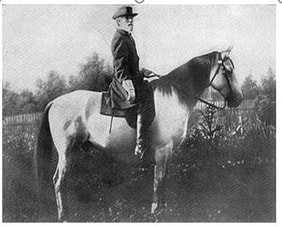 This Photo by Unknown Author is licensed under CC BY-SA Horses served an important role in the Civil War, and suffered as greatly as the men beneath them. It has been estimated that 1.5 million horses and mules died in the Civil War. Five million pounds of dead horses was removed from the Gettysburg battlefield alone. But of all the horses that served in this period, none is as famous as Traveller.
This Photo by Unknown Author is licensed under CC BY-SA Horses served an important role in the Civil War, and suffered as greatly as the men beneath them. It has been estimated that 1.5 million horses and mules died in the Civil War. Five million pounds of dead horses was removed from the Gettysburg battlefield alone. But of all the horses that served in this period, none is as famous as Traveller.Traveller, spelled as the British do, with two Ls, was an iron grey American Saddlebred with black points and a dark mane and tail. The 16-hand tall horse was sired by a race horse named Grey Eagle, who had won $20,000 in a Louisville, Kentucky stake race, and born in 1857 in Greenbrier County, in what is now West Virginia. His first owner named him “Jeff Davis,” after the Mississippi Senator and Mexican American War hero who eventually became the President of the Confederacy.
In 1861 the son of the original owner took the horse with him when he joined the legion of former Virginia governor Brig. Gen. Henry Wise. He sold the horse to Captain Joseph M. Broun, a quartermaster of Wise’s Legion’s 3rd Infantry. Broun renamed the horse “Greenbriar.” When Robert E. Lee arrived to advise Wise in late August 1861, he saw Broun’s horse and was immediately taken with him, calling the horse ‘my colt’ and saying he would need it before the war was over. Aware of the difference in their ranks, Broun offered to give the horse to Lee, who declined the offer. Broun then offered to sell Greenbriar to Lee for the same price he had himself paid for the horse. Lee added an extra $15 to cover the depreciating value of the Confederate dollar. Lee bought the horse in February 1862 and renamed him Traveller because of his ability to walk at a fast pace.
Although Traveller was not the only horse Lee rode from that time on, it was the one he rode and most and the one that became linked to him in the public’s eye. He was known for great endurance during long marches, and being unflappable in battle. He was not perfect, though. Lee’s youngest son, Robert E. Lee Jr later wrote that the horse fretted a lot, especially when in crowds if he wasn’t regularly exercised. At the Second Battle of Manassas he shied at enemy movements, rearing and throwing the General, who broke bones in both his hands during the fall. After the war, Lee continued to keep the grey near him. He brought Traveller to Washington University when he became its president, and the pair were a common site on campus. Traveller became such a celebrity that his mane and tail thinned because students plucked the dark hairs as souvenirs. Locks of Lee’s hair and Traveller’s mane are still part of the collection at Arlington House, Lee’s former home on the grounds of Arlington National Cemetery.
When Lee died in October of 1870, Traveller was draped in black crepe walked, riderless, behind the funeral hearse. Less than a year later, Traveller stepped on a nail and contracted tetanus. He died June of 1871 and was buried along a creek adjoining Washington University’s campus near Lee Chapel.
But Traveller’s story didn’t end with his death. In 1875, Custis Lee, who had succeeded his father as President of the institution that was renamed Washington and Lee University after the General’s death, exhumed Traveller and sent his bones to Henry Augustus Ward, a University of Rochester faculty member who traveled the world acquiring a massive assortment of geological and zoological specimens and taxidermy samples for museums.
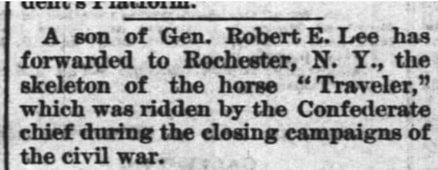 CLIPPED FROM The Times-Picayune New Orleans, Louisiana 15 Dec 1875, Wed
CLIPPED FROM The Times-Picayune New Orleans, Louisiana 15 Dec 1875, Wed
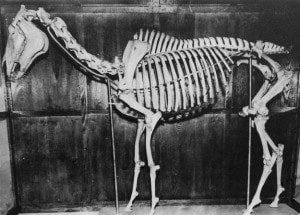 An undated image of Traveller’s skeleton on display in Lexington. The skeleton was returned to Washington and Lee in 1907, and later moved to the basement of Lee Chapel. By the time his bones were reburied in front of the chapel in 1960, the bones had deteriorated and were covered with the penned signatures of visitors. Jennifer Bohnhoff is a writer who lives in the mountains of central New Mexico. You can read about her on her website. You can read another story about a horse from history, Sergeant Reckless, an Army horse during the Korean war, here.
An undated image of Traveller’s skeleton on display in Lexington. The skeleton was returned to Washington and Lee in 1907, and later moved to the basement of Lee Chapel. By the time his bones were reburied in front of the chapel in 1960, the bones had deteriorated and were covered with the penned signatures of visitors. Jennifer Bohnhoff is a writer who lives in the mountains of central New Mexico. You can read about her on her website. You can read another story about a horse from history, Sergeant Reckless, an Army horse during the Korean war, here.
Published on June 27, 2021 00:00
June 6, 2021
The Mighty DUKWs
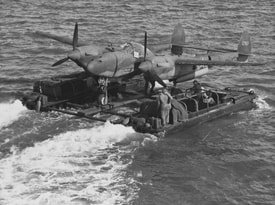 Two DUKWs carrying a P-38. (Photo: Worldwarphotos.info) fter World War II had ended, General Dwight Eisenhower wrote that while most of his senior officers considered the bulldozer, the Jeep, the 2,5-ton truck, and the C-47 airplane the four most vital pieces of military equipment to the Allies’ success, he thought that the DUKW was “one of the most valuable pieces of equipment produced by the United States during the war.” (Philip Handleman, and Walter J. Boyne, editors: Brassey’s Air Combat Reader, pg. 255). Not everyone shared Ike’s enthusiasm for the amphibious vehicles commonly called ‘ducks.” Their less than stellar performance during the D-Day invasion made many suspicious of them.
Two DUKWs carrying a P-38. (Photo: Worldwarphotos.info) fter World War II had ended, General Dwight Eisenhower wrote that while most of his senior officers considered the bulldozer, the Jeep, the 2,5-ton truck, and the C-47 airplane the four most vital pieces of military equipment to the Allies’ success, he thought that the DUKW was “one of the most valuable pieces of equipment produced by the United States during the war.” (Philip Handleman, and Walter J. Boyne, editors: Brassey’s Air Combat Reader, pg. 255). Not everyone shared Ike’s enthusiasm for the amphibious vehicles commonly called ‘ducks.” Their less than stellar performance during the D-Day invasion made many suspicious of them.
DUKW, which comes from the model-naming terminology used by GMC, is an acronym for the fact that it was “D,” designed in 1942, “U,” a utility vehicle that was “K,” all-wheel drive, with “W,” two rear axles. Soldiers, who had nicknames for everything, first called them Ducks. The vehicle was developed in only 38 days through a collaboration between yacht designers Sparkman & Stephens and General Motors. It had a 104 horsepower Chevy engine which was able to reach 50 mph on land and 6 mph on water. They were 31 feet long, 8 feet wide, and 7 feet high. A quarter of the 21,000+ DUKWs that were manufactured between 1942 and 1945 had .50 caliber Browning machine guns ring-mounted to them.
 A DUKW at Utah Beach. In front, a soldier inspects a German Goliath tracked mine. (Photo: world-war-2.wikia.org) DUKWs, which were able to carry a payload of 2.5 tons, or around 20 troops with all their equipment, were originally designed to allow the military to drop cargo off where there were no ports at which to dock supply ships. It was the first vehicle to come equipped with a Speir's Device, a central tire inflation system which allowed drivers to vary the tire pressure to adapt to different surfaces. Fully inflated tires were good for hard surfaces such as roads, while softer tires gave better grip on beach sand.
A DUKW at Utah Beach. In front, a soldier inspects a German Goliath tracked mine. (Photo: world-war-2.wikia.org) DUKWs, which were able to carry a payload of 2.5 tons, or around 20 troops with all their equipment, were originally designed to allow the military to drop cargo off where there were no ports at which to dock supply ships. It was the first vehicle to come equipped with a Speir's Device, a central tire inflation system which allowed drivers to vary the tire pressure to adapt to different surfaces. Fully inflated tires were good for hard surfaces such as roads, while softer tires gave better grip on beach sand.The Army was not impressed with its design at first, and rejected them. However, when a Coast Guard patrol craft ran aground on a sand bar during a storm near Provincetown, Massachusetts, a prototype DUKW that was being tested nearby was able to save the patrol craft’s crew. The Army, now aware of the craft’s versatility, changed its mind. By March 1943, they were successfully being used in Guadalcanal in the South Pacific. They were also used to great effect in Operation Husky, the 1943 invasion of Sicily. In addition to their normal transport duties, DUKWs were used as naval ambulances and for providing fire support to landing troops.
Opinions on DUKWs changed after their failure during the D-Day Invasion, where all but one of the vehicles being used to haul howitzers to Omaha Beach sank shortly after debarking from their carriers. This wasn’t a failure of the vehicle so much as a failure of command to understand the DUKW’s limitations. In good weather, DUKWs perform well. In bad weather, especially in high waves and when loaded with heavy cargo such as howitzers, they are not seaworthy.
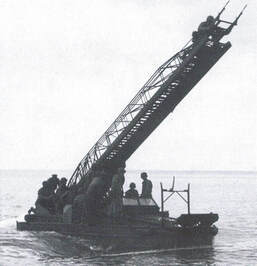 The specially modified DUKW with an extension ladder used at Pointe du Hoc (Photo: Mikesresearch.com) Not all DUKWs performed badly, even on the choppy waters of the Norman Coast. U.S. Rangers used specially modified DUKWs with 100foot extension ladders to climb the steep cliffs of Pointe du Hoc to take out the German gun emplacements there.
The specially modified DUKW with an extension ladder used at Pointe du Hoc (Photo: Mikesresearch.com) Not all DUKWs performed badly, even on the choppy waters of the Norman Coast. U.S. Rangers used specially modified DUKWs with 100foot extension ladders to climb the steep cliffs of Pointe du Hoc to take out the German gun emplacements there.
Most DUKWs were decommissioned after World War II. A few hundred went to the Korean War and to Vietnam, while others were distributed to police and civilian search-and-rescue units, where they continue to serve.
 Jennifer Bohnhoff's historical novel Code: Elephants on the Moon tells the story of a young French woman who becomes involved in the Resistance movement in preparation for the Allied Invasion on D-Day. You can see pictures of the village where the action takes place here.
Jennifer Bohnhoff's historical novel Code: Elephants on the Moon tells the story of a young French woman who becomes involved in the Resistance movement in preparation for the Allied Invasion on D-Day. You can see pictures of the village where the action takes place here.
Published on June 06, 2021 00:00
May 30, 2021
Horses in History: The Four Legged Sergeant
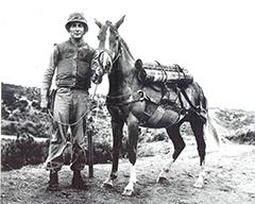 http://www.horsestarhalloffame.org Photo courtesy U.S. Marines The horse that came to be known as Sergeant Reckless was bred to be a runner, but she earned her fame by standing firm in battle. Part Jeju, a sturdy breed of small horse native to an island in South Korea, the sorrel mare was born at a Seoul racetrack and was destined for a racing career. The outbreak of the Korean War in 1950 changed all that.
http://www.horsestarhalloffame.org Photo courtesy U.S. Marines The horse that came to be known as Sergeant Reckless was bred to be a runner, but she earned her fame by standing firm in battle. Part Jeju, a sturdy breed of small horse native to an island in South Korea, the sorrel mare was born at a Seoul racetrack and was destined for a racing career. The outbreak of the Korean War in 1950 changed all that.In October 1952, the owner of the three-year-old filly, whose original name was “Ah Chim Hai,” which means “Morning Flame,” sold her to Lieutenant Eric Pedersen of the 5th Marine Regiment’s Recoilless Rifle Platoon so that he could buy a prosthesis for his sister, who had lost a leg in a land mine explosion.
Pedersen was willing to pay $250 for her because he needed help supplying his positions in mountainous terrain that had proven too difficult for motorized vehicles. To prepare her for her new job, Technical Sergeant Joe Latham put her through “hoof camp,” a boot camp for horses where she learned to accept the chaos and noise of battle and to carry the 24-pound ammunition shells that the Marine’s 75mm recoilless rifles required. The filly also learned how to step over communication lines and barbed wire, and she learned to respond to a shouted ‘Incoming!’ by running to a bunker or trench and lying down. By the time she was ready for service, she had learned to navigate all the service roads between the supply depot and the front lines by herself.
 Sgt Reckless with a recoilless-rifle. (Credit: Archive PL/Alamy Stock Photo) There are two different stories about how she got her name. One is that she was named after the recoilless rifles, called "reckless rifles" in Marine jargon, which she carried to the troops. That the unit themselves were nicknamed the Reckless Rifles supplies the other explanation.
Sgt Reckless with a recoilless-rifle. (Credit: Archive PL/Alamy Stock Photo) There are two different stories about how she got her name. One is that she was named after the recoilless rifles, called "reckless rifles" in Marine jargon, which she carried to the troops. That the unit themselves were nicknamed the Reckless Rifles supplies the other explanation.
Once she was named after them, Reckless became "one of the men." She followed them everywhere, sleeping with them in their tents and eating with them in the mess hall. Reckless ate bacon, scrambled eggs and coffee for breakfast, and she liked to snack on candy bars and Coca-Cola. She even drank beer with her fellow Marines.
Reckless carried supplies to the front and evacuated wounded Marines back down the slope for medical treatment without a human escort. On a single day in March 1953, when the unit was entrenched at a place called Outpost Vegas, so named because it would be a gamble to hold, Reckless made 51 rounds trips through a no-man’s land of rice paddies and steep hills. She delivered almost 9,000 pounds of ammunition from the supply point to the gun teams and probably saved the lives of the dozens of men she brought back to the medical unit.
Reckless received two shrapnel wounds that earned her a pair of Purple Hearts. She was given a battlefield rank of corporal in 1953 and promoted to sergeant after the war, when she was also awarded a Marine Corps Good Conduct Medal. She was the only animal ever awarded an official rank in the Marine Corps.
 Jennifer Bohnhoff writes historical fiction that is suitable for middle grade readers and older. Her novel Code: Elephants on the Moon is set in Normandy, France during World War Two and features Galopin, a Breton horse who helps his owner in the Resistance against the German occupation.
Jennifer Bohnhoff writes historical fiction that is suitable for middle grade readers and older. Her novel Code: Elephants on the Moon is set in Normandy, France during World War Two and features Galopin, a Breton horse who helps his owner in the Resistance against the German occupation.
Published on May 30, 2021 00:00
May 23, 2021
Albuquerque Historical Site: La Glorieta
 https://sah-archipedia.org/buildings/... La Glorieta has seen a lot of history. Albuquerque’s only surviving example of a Spanish Colonial hacienda, it was later owned by one of people who helped transform the town from a sleepy village to a railroad town.
https://sah-archipedia.org/buildings/... La Glorieta has seen a lot of history. Albuquerque’s only surviving example of a Spanish Colonial hacienda, it was later owned by one of people who helped transform the town from a sleepy village to a railroad town.
In 1662, a soldier from Mexico City named Diego de Trujillo established a hacienda near what would later become Albuquerque’s Old Town. The house was damaged in 1680, when the Pueblo Revolt forced its occupants to flee the territory. They returned after 1692, during the period called the Reconquista, and rebuilt their home. The north and east wings of the twelve room, one-story adobe building that still stands might possibly date from this period.
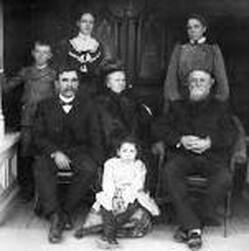 In 1861, Franz Huning, a German immigrant who had opened a mercantile in Albuquerque’s Old Town, bought the property from the Franciscans. In addition to the eight-room hacienda, which Huning named La Glorieta, Spanish for arbor, the property included 700 acres of fields on which Huning grew crops. He added south and west wings to the house, creating a fully enclosed patio at its center. He also built a sawmill and a gristmill on the property.
In 1861, Franz Huning, a German immigrant who had opened a mercantile in Albuquerque’s Old Town, bought the property from the Franciscans. In addition to the eight-room hacienda, which Huning named La Glorieta, Spanish for arbor, the property included 700 acres of fields on which Huning grew crops. He added south and west wings to the house, creating a fully enclosed patio at its center. He also built a sawmill and a gristmill on the property.
Huning’s mercantile business depended on goods that he brought in along the Santa Fe Trail from Missouri. He was in St. Louis on business when, in 1862, the retreating Confederate Army of New Mexico, under the command of Major General Henry Hopkins Sibley, occupied La Glorieta. The officers lived in the home while the enlisted men camped in the nearby fields. The Confederates fired their cannons from the grounds of the gristmill during the artillery duel that became known as the Battle of Albuquerque.
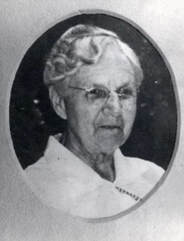 https://www.albuqhistsoc.org/programs... Huning returned to Albuquerque in 1864 with a new wife, Ernestine Franke. They lived their for nineteen years, until 1883, when he built a new mansion, Castle Huning, down the street. In 1887 he deeded La Glorieta to his eldest daughter Clara as a wedding present when she married a local attorney named Harvey Butler Fergusson. They raised four children, including author Erna Fergusson, who has an Albuquerque Public Library named after her.
https://www.albuqhistsoc.org/programs... Huning returned to Albuquerque in 1864 with a new wife, Ernestine Franke. They lived their for nineteen years, until 1883, when he built a new mansion, Castle Huning, down the street. In 1887 he deeded La Glorieta to his eldest daughter Clara as a wedding present when she married a local attorney named Harvey Butler Fergusson. They raised four children, including author Erna Fergusson, who has an Albuquerque Public Library named after her. In 1940, Ruth Hanna McCormick Simms, a former Illinois congresswoman, bought
La Glorieta to house Manzano Day School, a private elementary school that she had started two years earlier. She had moved to Albuquerque after marrying local businessman and former New Mexico congressman, Albert Gallatin Simms, and established the school to provide an education for her daughter and the children of other prominent families.
Today, La Glorieta houses the administrative offices of the school. It is closed to the public, but tours and visits can be arranged by appointment
Jennifer Bohnhoff is an author and educator who lives in the mountains east of Albuquerque. She is presently working on Peralta, the third book in a trilogy set in New Mexico during the Civil War. Valverde, the first book in the series, has been recently acquired by Artemesia Press, who will publish it in May 2022.
Published on May 23, 2021 16:40
May 16, 2021
The Civil War Battle of Albuquerque
 La Glorieta today. It was originally built sometime before 1803. John Phelan, CC BY-SA 3.0 , via Wikimedia Commons The Battle of Albuquerque was one of the least significant battles of the American Civil War. It was so small that it is more appropriately called a skirmish.
La Glorieta today. It was originally built sometime before 1803. John Phelan, CC BY-SA 3.0 , via Wikimedia Commons The Battle of Albuquerque was one of the least significant battles of the American Civil War. It was so small that it is more appropriately called a skirmish. General H.H. Sibley’s Army of New Mexico had begun with great intentions. Its leader had planned to take the California and Colorado goldfields at little cost to the Confederacy, fulfilling a Southern version of Manifest Destiny. But things went wrong from the start, and they soon discovered that New Mexicans were not as happy to see them nor willing to feed and shelter an army made up of Texans. After its supply train was destroyed while they were fighting the Battle of Glorieta Pass, Sibley’s army retreated to Santa Fe and began straggling into Albuquerque, where they commandeered La Glorieta, the already old hacienda that was owned by German entrepreneur Franz Huning and its accompanying grist mill.
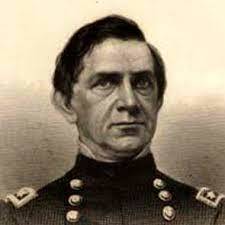 Col. E.R.S. Canby Meanwhile, Col. Canby, whose troops had been bottled up in Fort Craig and living on half rations, moved his men north, leaving Kit Carson and his New Mexico Volunteers to defend the fort. On April 8 Canby arrived at the small farming settlement of Barelas, south of Albuquerque. Scouting reports informed him that the main Rebel force had not yet arrived from Santa Fe and only a small group of Confederates held the town. Canby decided to use his four pieces of artillery to make what he called a “noisy demonstration.” Rebel cannons returned fire from the mill, which was located near what is now the intersection of Laguna and Central. The artillery duel lasted for several hours until a delegation of concerned citizens approached Canby under a white flag. They explained that Sibley had refused to allow the town’s women and children to evacuate, and the Union shelling was endangering them. Rather than risk public opinion in a territory that wasn’t wholly supportive of American rule, Canby ordered his men to stop firing, ending the Battle of Albuquerque. The townspeople and the Confederates didn’t know it was over, however. They waited anxiously as the sunset glowed red, orange and pink. In the fading light, the yellow glow of Canyby’s campfires dotted the horizon. Union buglers, drummers and fifers played “Tattoo” marking the end of the day, then continued with more music as, gradually, the campfires died out. It wasn’t until morning that it became apparent that Canby and his troops had slipped away in the darkness, leaving the musicians and the campfires to cover their movement.
Col. E.R.S. Canby Meanwhile, Col. Canby, whose troops had been bottled up in Fort Craig and living on half rations, moved his men north, leaving Kit Carson and his New Mexico Volunteers to defend the fort. On April 8 Canby arrived at the small farming settlement of Barelas, south of Albuquerque. Scouting reports informed him that the main Rebel force had not yet arrived from Santa Fe and only a small group of Confederates held the town. Canby decided to use his four pieces of artillery to make what he called a “noisy demonstration.” Rebel cannons returned fire from the mill, which was located near what is now the intersection of Laguna and Central. The artillery duel lasted for several hours until a delegation of concerned citizens approached Canby under a white flag. They explained that Sibley had refused to allow the town’s women and children to evacuate, and the Union shelling was endangering them. Rather than risk public opinion in a territory that wasn’t wholly supportive of American rule, Canby ordered his men to stop firing, ending the Battle of Albuquerque. The townspeople and the Confederates didn’t know it was over, however. They waited anxiously as the sunset glowed red, orange and pink. In the fading light, the yellow glow of Canyby’s campfires dotted the horizon. Union buglers, drummers and fifers played “Tattoo” marking the end of the day, then continued with more music as, gradually, the campfires died out. It wasn’t until morning that it became apparent that Canby and his troops had slipped away in the darkness, leaving the musicians and the campfires to cover their movement. Unwilling to face Sibley’s entire army, which might reach Albuquerque at any moment, Canby had moved his men eastward into the Sandia Mountains. A few days later in the little village of San Antonio, he met up with the Colorado volunteers now under the command of John Chivington, and finally felt that his troops were large enough to resume the attack on Gen. Sibley.
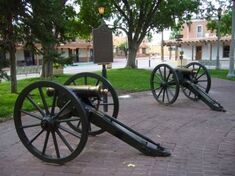 The howitzer replicas, Old Town Albuquerque But Sibley’s forces had left Albuquerque, ending a possible second act of the Battle of Albuquerque. The General had arrived in Albuquerque soon after the artillery exchange and explained to his officers that, with only enough food for 15 days and no more than 40 rounds of ammunition per man, the best course of action would be to retreat down the Rio Grande valley and return to Texas. So that they couldn’t be used against his retreating troops, he had eight brass howitzers buried in a corral behind San Felipe Neri Church. On the morning of April 12, Sibley abandoned his wounded and proceeded south. The two armies would not encounter each other until two days later, at the Battle of Peralta.
The howitzer replicas, Old Town Albuquerque But Sibley’s forces had left Albuquerque, ending a possible second act of the Battle of Albuquerque. The General had arrived in Albuquerque soon after the artillery exchange and explained to his officers that, with only enough food for 15 days and no more than 40 rounds of ammunition per man, the best course of action would be to retreat down the Rio Grande valley and return to Texas. So that they couldn’t be used against his retreating troops, he had eight brass howitzers buried in a corral behind San Felipe Neri Church. On the morning of April 12, Sibley abandoned his wounded and proceeded south. The two armies would not encounter each other until two days later, at the Battle of Peralta.
Although hardly a battle, the artillery duel is the only battle ever to be fought within the city limits of Albuquerque. The eight brass howitzers were later recovered, and two are preserved in The Albuquerque Museum and replicas of the guns stand around the edges of Albuquerque's Old Town Plaza..
 Jennifer Bohnhoff teaches New Mexico history at Edgewood Middle School, in central New Mexico. She is the author of two novels set in the Civil War in New Mexico, Valverde and Glorieta, and is at work on Peralta, the third and final book in the trilogy. The Battle of Albuquerque will be depicted in that book.
Jennifer Bohnhoff teaches New Mexico history at Edgewood Middle School, in central New Mexico. She is the author of two novels set in the Civil War in New Mexico, Valverde and Glorieta, and is at work on Peralta, the third and final book in the trilogy. The Battle of Albuquerque will be depicted in that book.
Published on May 16, 2021 00:00
May 3, 2021
American Mothers and Authors
May is the month in which we celebrate Mother's Days, so it seems appropriate to recognize some American mothers who were also authors. 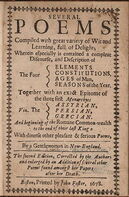 Anne Bradstreet (March 20, 1612 – September 16, 1672) was the wife of the governor of the Massachusetts Colony and the mother of eight children, but she was also a poet who wrote about marriage, family and the natural world. Her first book of poetry, The Tenth Muse Lately Sprung Up in America, was published in London in 1650, making her the first American woman to be published in Europe and the New World.
Anne Bradstreet (March 20, 1612 – September 16, 1672) was the wife of the governor of the Massachusetts Colony and the mother of eight children, but she was also a poet who wrote about marriage, family and the natural world. Her first book of poetry, The Tenth Muse Lately Sprung Up in America, was published in London in 1650, making her the first American woman to be published in Europe and the New World.
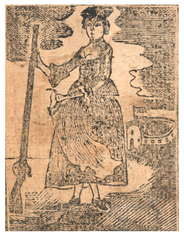 Illustration from a 1770 edition of Rowlandson's book. Mary Rowlandson (c. 1637 – January 5, 1711) was the wife of a minister and mother of four children, one of whom died in infancy. The family lived in Lancaster, Massachusetts, a town that was on the edge of the wilderness at that time. In 1676, during King Philip's War, Lancaster was raided by Narragansett, Wampanoag, and Nipmuc Indians, and Mary and her her three children were taken. One of her daughters died of wounds after a week of captivity, but Mary and her remaining two children were ransomed after eleven weeks. Six years later, Rowlandson published
The Sovereignty and Goodness of God: Being a Narrative of the Captivity and Restoration of Mrs. Mary Rowlandson,
which many consider to be America's first best-seller.
Illustration from a 1770 edition of Rowlandson's book. Mary Rowlandson (c. 1637 – January 5, 1711) was the wife of a minister and mother of four children, one of whom died in infancy. The family lived in Lancaster, Massachusetts, a town that was on the edge of the wilderness at that time. In 1676, during King Philip's War, Lancaster was raided by Narragansett, Wampanoag, and Nipmuc Indians, and Mary and her her three children were taken. One of her daughters died of wounds after a week of captivity, but Mary and her remaining two children were ransomed after eleven weeks. Six years later, Rowlandson published
The Sovereignty and Goodness of God: Being a Narrative of the Captivity and Restoration of Mrs. Mary Rowlandson,
which many consider to be America's first best-seller.
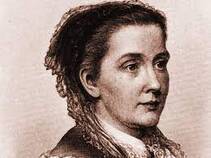 Julia Ward Howe (May 27, 1819 – October 17, 1910) may be best know as the author of the “Battle Hymn of the Republic,” but it is just one of many poems she wrote. In addition, she was the author of plays, and books, and the publisher of literary magazines. She was also the mother of six children, active in advocating for world peace, women’s education, and women's right to vote. Julia wrote extensively over the course of her life and was also active as a speaker who championed morality and Christianity.
Julia Ward Howe (May 27, 1819 – October 17, 1910) may be best know as the author of the “Battle Hymn of the Republic,” but it is just one of many poems she wrote. In addition, she was the author of plays, and books, and the publisher of literary magazines. She was also the mother of six children, active in advocating for world peace, women’s education, and women's right to vote. Julia wrote extensively over the course of her life and was also active as a speaker who championed morality and Christianity.
In 1872, Howe asked for June 2 to become a "Mother's Day for Peace." Although she was unsuccessful, Anna Jarvis, the women who managed to establish the modern Mother's Day 36 years later reportedly was inspired by her own mother's work with Howe.
Vanilla Wafers Surely you've bought a box of vanilla wafers before. Why not make them yourself? These not too sweet cookies are perfect for accompanying a bowl of strawberries or a fruit salad, or as the base in banana pudding. If you are having a mother's day celebration, be sure to include them.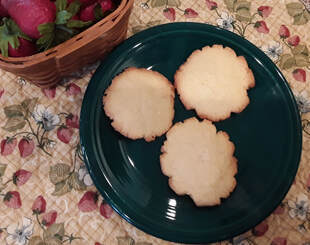 1/2 cup butter
1/2 cup butter
1.2 cup shortening
2/3 cup sugar
2 tsp. vanilla
1 tsp salt
2 eggs
2 3/4 cups flour Cream butter, shortening and sugar together until fluffy. Add vanilla and salt. Add eggs, one at a time, beating well after each. Stir in flour.
Scoop up dough with a teaspoon, roll into a ball, then set on a parchment-lined cookie sheet, 2" apart. Flatten with the bottom of a glass that has been dipped in flour so it doesn't stick.
Bake at 375 for 10-12 minutes, until browned on the edges. Let cook on a rack.
 Jennifer Bohnhoff is the mother of three fine sons, the mother-in-law of three wonderful daughters in law, and the grandmother of three granddaughters and one grandson. She lives in New Mexico, where she teaches New Mexico History and writes. You can find out more about her at her website.
Jennifer Bohnhoff is the mother of three fine sons, the mother-in-law of three wonderful daughters in law, and the grandmother of three granddaughters and one grandson. She lives in New Mexico, where she teaches New Mexico History and writes. You can find out more about her at her website.
 Anne Bradstreet (March 20, 1612 – September 16, 1672) was the wife of the governor of the Massachusetts Colony and the mother of eight children, but she was also a poet who wrote about marriage, family and the natural world. Her first book of poetry, The Tenth Muse Lately Sprung Up in America, was published in London in 1650, making her the first American woman to be published in Europe and the New World.
Anne Bradstreet (March 20, 1612 – September 16, 1672) was the wife of the governor of the Massachusetts Colony and the mother of eight children, but she was also a poet who wrote about marriage, family and the natural world. Her first book of poetry, The Tenth Muse Lately Sprung Up in America, was published in London in 1650, making her the first American woman to be published in Europe and the New World.
 Illustration from a 1770 edition of Rowlandson's book. Mary Rowlandson (c. 1637 – January 5, 1711) was the wife of a minister and mother of four children, one of whom died in infancy. The family lived in Lancaster, Massachusetts, a town that was on the edge of the wilderness at that time. In 1676, during King Philip's War, Lancaster was raided by Narragansett, Wampanoag, and Nipmuc Indians, and Mary and her her three children were taken. One of her daughters died of wounds after a week of captivity, but Mary and her remaining two children were ransomed after eleven weeks. Six years later, Rowlandson published
The Sovereignty and Goodness of God: Being a Narrative of the Captivity and Restoration of Mrs. Mary Rowlandson,
which many consider to be America's first best-seller.
Illustration from a 1770 edition of Rowlandson's book. Mary Rowlandson (c. 1637 – January 5, 1711) was the wife of a minister and mother of four children, one of whom died in infancy. The family lived in Lancaster, Massachusetts, a town that was on the edge of the wilderness at that time. In 1676, during King Philip's War, Lancaster was raided by Narragansett, Wampanoag, and Nipmuc Indians, and Mary and her her three children were taken. One of her daughters died of wounds after a week of captivity, but Mary and her remaining two children were ransomed after eleven weeks. Six years later, Rowlandson published
The Sovereignty and Goodness of God: Being a Narrative of the Captivity and Restoration of Mrs. Mary Rowlandson,
which many consider to be America's first best-seller.
 Julia Ward Howe (May 27, 1819 – October 17, 1910) may be best know as the author of the “Battle Hymn of the Republic,” but it is just one of many poems she wrote. In addition, she was the author of plays, and books, and the publisher of literary magazines. She was also the mother of six children, active in advocating for world peace, women’s education, and women's right to vote. Julia wrote extensively over the course of her life and was also active as a speaker who championed morality and Christianity.
Julia Ward Howe (May 27, 1819 – October 17, 1910) may be best know as the author of the “Battle Hymn of the Republic,” but it is just one of many poems she wrote. In addition, she was the author of plays, and books, and the publisher of literary magazines. She was also the mother of six children, active in advocating for world peace, women’s education, and women's right to vote. Julia wrote extensively over the course of her life and was also active as a speaker who championed morality and Christianity. In 1872, Howe asked for June 2 to become a "Mother's Day for Peace." Although she was unsuccessful, Anna Jarvis, the women who managed to establish the modern Mother's Day 36 years later reportedly was inspired by her own mother's work with Howe.
Vanilla Wafers Surely you've bought a box of vanilla wafers before. Why not make them yourself? These not too sweet cookies are perfect for accompanying a bowl of strawberries or a fruit salad, or as the base in banana pudding. If you are having a mother's day celebration, be sure to include them.
 1/2 cup butter
1/2 cup butter1.2 cup shortening
2/3 cup sugar
2 tsp. vanilla
1 tsp salt
2 eggs
2 3/4 cups flour Cream butter, shortening and sugar together until fluffy. Add vanilla and salt. Add eggs, one at a time, beating well after each. Stir in flour.
Scoop up dough with a teaspoon, roll into a ball, then set on a parchment-lined cookie sheet, 2" apart. Flatten with the bottom of a glass that has been dipped in flour so it doesn't stick.
Bake at 375 for 10-12 minutes, until browned on the edges. Let cook on a rack.
 Jennifer Bohnhoff is the mother of three fine sons, the mother-in-law of three wonderful daughters in law, and the grandmother of three granddaughters and one grandson. She lives in New Mexico, where she teaches New Mexico History and writes. You can find out more about her at her website.
Jennifer Bohnhoff is the mother of three fine sons, the mother-in-law of three wonderful daughters in law, and the grandmother of three granddaughters and one grandson. She lives in New Mexico, where she teaches New Mexico History and writes. You can find out more about her at her website.
Published on May 03, 2021 00:00
April 25, 2021
Welsh Border Castles
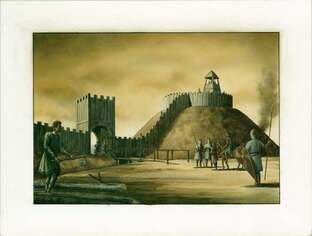 Motte and bailey design The Welsh border with England was the most heavily fortified frontier in Europe during the Middle Ages. Between 1066 and 1200, hundreds of castles were built there, at least 250 in Herefordshire and Shropshire alone..
Motte and bailey design The Welsh border with England was the most heavily fortified frontier in Europe during the Middle Ages. Between 1066 and 1200, hundreds of castles were built there, at least 250 in Herefordshire and Shropshire alone..The first of these castles were motte and baileys. The motte, an earthen mound with a tower on it that was the home of the local lord, was surrounded by a bailey, an enclosed area that usually had the stables, areas for storage, a chapel, and a well. The walls and buildings were made of wood initially.. After William successfully led the Normans in the 1066 invasion, he had to work quickly to secure his borders, and building with wood was the quickest was to build a fortification.
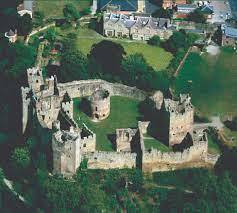 The Normans struggled to maintain their grip against sporadic Welsh raids along the border. Their kings granted great powers to the border lordships so they would act as a buffer zone. Powerful feudal families, such as the Mortimers, dug in, building bigger and stronger castles such as the one at Ludlow.
The Normans struggled to maintain their grip against sporadic Welsh raids along the border. Their kings granted great powers to the border lordships so they would act as a buffer zone. Powerful feudal families, such as the Mortimers, dug in, building bigger and stronger castles such as the one at Ludlow. By the end of the 12th century, these border lords began replacing their wooden structures with more permanent stone ones. Stone keeps, some with bed chambers that had fireplaces and windows with dramatic views, replaced the wooden towers. Wooden palisades were replaced with stone curtain walls, which often had stone towers in their corners to improve their defenses. But this transformation was expensive, and where it was not needed, it was not pursued. By the end of the 13th century, Edward I had subdued the Welsh and the need for fortified castles declined. Many of the early motte and baileys were abandoned. Their timber defenses rotted away, leaving only the earthwork mounds. The remaining castles became more comfortable homes with the addition of pleasure gardens and larger doorways and windows on the lower floors.
 Jennifer Bohnhoff is a middle school history teacher and author who lives in the mountains of central New Mexico. She has written one book set in Medieval Europe. You can read more about it here.
Jennifer Bohnhoff is a middle school history teacher and author who lives in the mountains of central New Mexico. She has written one book set in Medieval Europe. You can read more about it here.
Published on April 25, 2021 00:00
April 18, 2021
A Tribute to Philip, Warrior Prince
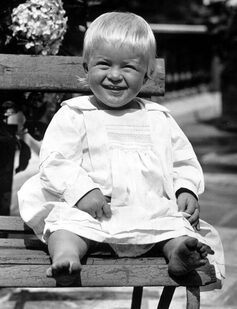 Prince Philip was born into war. When Princess Alice of Battenberg gave birth to him on the Greek island of Corfu on June 10, 1921, the Greco-Turkish War had already been raging for two years. His father, Prince Andrew of Greece, commanded a Greek Army division and his uncle, King Constantine I, was the high commander of the Greek expeditionary force. The only son and fifth child, Philip’s parents had him baptized into the Greek Orthodox Church. As a member of the House of Schleswig-Holstein-Sonderburg-Glücksburg, he was in line of succession to both the Greek and the Danish thrones.
Prince Philip was born into war. When Princess Alice of Battenberg gave birth to him on the Greek island of Corfu on June 10, 1921, the Greco-Turkish War had already been raging for two years. His father, Prince Andrew of Greece, commanded a Greek Army division and his uncle, King Constantine I, was the high commander of the Greek expeditionary force. The only son and fifth child, Philip’s parents had him baptized into the Greek Orthodox Church. As a member of the House of Schleswig-Holstein-Sonderburg-Glücksburg, he was in line of succession to both the Greek and the Danish thrones.But the war was going badly, and when Philip was just 18 months old, Greeks revolted against their King. Constantine was forced to abdicate, and Prince Andrew, his wife, four daughters, and infant son were banished. The family escaped on the British naval vessel HMS Calypso, where the infant Philip slept in a cot made from a fruit box. In Paris, an aunt took them in.
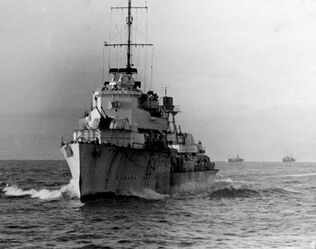 The HMS Wallace. It had the nickname "One round Wallace", as the very first shot it fired in the war brought down a German airplane The family spiraled down after that. Philip was shuffled from school to school, beginning in Paris, then moved first to a British school, then a German one. As the Nazi party grew, his school moved to Scotland, and from there he moved to the Royal Naval College in Dartmouth. As he shuffled from school to school, his four sisters married German princes and joined the Nazi party, his mother was committed to an asylum for schizophrenia, and his father moved to Monte Carlo. The young prince was left in the care of his uncle and guardian, Lord Milford Haven. When Haven died of cancer, his brother Louis Mountbatten, took over Philip’s guardianship, and Philip took the name Mountbatten as his own.
The HMS Wallace. It had the nickname "One round Wallace", as the very first shot it fired in the war brought down a German airplane The family spiraled down after that. Philip was shuffled from school to school, beginning in Paris, then moved first to a British school, then a German one. As the Nazi party grew, his school moved to Scotland, and from there he moved to the Royal Naval College in Dartmouth. As he shuffled from school to school, his four sisters married German princes and joined the Nazi party, his mother was committed to an asylum for schizophrenia, and his father moved to Monte Carlo. The young prince was left in the care of his uncle and guardian, Lord Milford Haven. When Haven died of cancer, his brother Louis Mountbatten, took over Philip’s guardianship, and Philip took the name Mountbatten as his own.
While he was at Dartmouth, King George VI and Queen Elizabeth visited, and Philip was asked to escort the King's two daughters, who were his third cousins through Queen Victoria. The king’s older daughter, Elizabeth, who was only 13, began exchanging letter with Philip soon after that.
In 1940, Philip graduated from Dartmouth as the best cadet in his class. He was appointed as a midshipman and served in the Indian Ocean aboard the battleship HMS Ramillies,the HMS Kent, and the HMS Shropshire. After Italy invaded Greece in October, he transferred to the battleship HMS Valiant, which was sailing in the Mediterranean. He fought in the Battle of Crete, and the March, 1941 Battle of Cape Matapan, where the 19-year-old sub-lieutenant was in charge of manning the searchlights used to spot enemy ships. He found two different targets, which his battleship was able to sink, earning himself the Greek War Cross.
By July 1943, Philip was a first lieutenant serving on the destroyer HMS Wallace. During the Allied Invasion of Sicily, the Wallace was targeted by a Luftwaffe bomber who repeatedly attacked. Philip came up with the idea of assembling a wooden raft, which they loaded with smoke pots and launched. Apparently, the German pilot mistook the smoking, flaming raft for the Wallace, which was able to slip away in the dark of night.
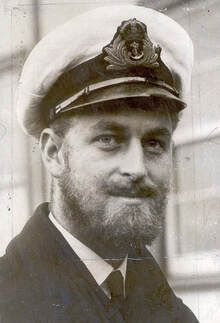 The 1945 picture of Philip that Elizabeth kept on her dressing table throughout the last year of the war. In 1944, Prince Philip was transferred to the Pacific, where he served aboard the HMS Whelp. Two rescued British airmen whose bomber was shot down by the Japanese over the ocean discovered who he was only after they saw Princess Elizabeth's photo in his cabin, where he had left them as he collected hot food and dry clothes for them. Elizabeth had a picture of the bearded lieutenant on her dressing table, but no down pilots sat on her bed while awaiting supplies.
The 1945 picture of Philip that Elizabeth kept on her dressing table throughout the last year of the war. In 1944, Prince Philip was transferred to the Pacific, where he served aboard the HMS Whelp. Two rescued British airmen whose bomber was shot down by the Japanese over the ocean discovered who he was only after they saw Princess Elizabeth's photo in his cabin, where he had left them as he collected hot food and dry clothes for them. Elizabeth had a picture of the bearded lieutenant on her dressing table, but no down pilots sat on her bed while awaiting supplies.After the war ended, Philip asked the King for his daughter's hand in marriage. The King asked that a formal engagement be delayed until Elizabeth's 21st birthday, in April of 1947.
Philip had to relinquish his Greek and Danish royal titles, but he did not give up his position in the Navy. After his marriage on November 20, 1947, he continued to serve, first at the Admiralty, and then at the Navel Staff College in Greenwich. He eventually was promoted to commander, and commanded the frigate HMS Magpie. In 1952, Elizabeth’s father, King George VI died and Elizabeth ascended the throne. Philip then gave up his military career to support his wife, but he continued to hold many honorary titles in the Army, the Navy and the Air Force. He also received pilot training with the RAF, and continued flying until the late 1990s. He remained a warrior at heart throughout his life. Jennifer Bohnhoff is an educator and writer who lives far from the sea, in the mountains of central New Mexico. When she was a young girl attending Oxford University in the late 1970s, it was rumored that Philip might just become her father in law. You can read more about that here. For more about her books, visit her website.
Published on April 18, 2021 13:18
April 12, 2021
Fimbulwinter and The Promise of Spring
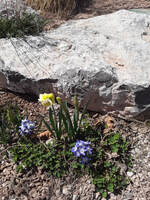 Spring is so full of promise. The emergence of the first, green shoots and the twitter of nesting birds inspires hope in our hearts. But what if, one spring, that didn't happen? How would it affect us?
Spring is so full of promise. The emergence of the first, green shoots and the twitter of nesting birds inspires hope in our hearts. But what if, one spring, that didn't happen? How would it affect us?
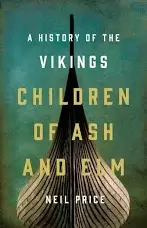 In Children of Ash and Elm, Neil Price suggests that the Viking's concept of Ragnarok, the cataclysmic final battle at the end of the world, might have been formed when volcanic eruptions threw so much ash into the atmosphere that spring seemed not to come. In 536, 539, and 547, major volcanic eruptions, probably in El Salvador at what is now Lake Ilopango, caused world wide ecological consequences that are documented in written sources as far divergent as China, India, the Mediterranean, and the Goths of central Europe.
In Children of Ash and Elm, Neil Price suggests that the Viking's concept of Ragnarok, the cataclysmic final battle at the end of the world, might have been formed when volcanic eruptions threw so much ash into the atmosphere that spring seemed not to come. In 536, 539, and 547, major volcanic eruptions, probably in El Salvador at what is now Lake Ilopango, caused world wide ecological consequences that are documented in written sources as far divergent as China, India, the Mediterranean, and the Goths of central Europe.Fimbulwinter, or Mighty Winter of Scandinavian lore may have been inspired by this. Snorri, in his Edda, says that when Fimbulwinter comes, "there will be great frosts and keen winds. The sun will do no good. There will be three of these winters together, and no summer between."
Dendrochronological records from this period show that trees withered, their growth rings stunted. The failed harvests created riots and famine. In Scandinavia, tens of thousands starved to death, and the population suffered losses of an estimated 50%. Price says that this devastation led to a dissolution of the sociopolitical structures in Scandinavia, and the beginning of what is called the Viking age. What they feared to be the end of civilization proved to be the beginning of a new era.
The Vikings were in no way responsible for the destruction of the ecology in the 6th century. Those volcanic eruptions were a natural occurrence. And while natural disasters continue to happen, it seems that many others are not natural at all, but human made.
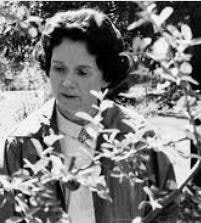 In her 1962 book Silent Spring, biologist Rachel Carson warned that the heightened use of DDT and other pesticides after World War II was going to lead to a human-created Fimbulwinter. In our attempt to choose what species were to live and what were to die because we had deemed them pests, humans were going to destroy the food chain, leading to the death of far more species than we intended. As birds' shells became thinner, their chicks would die. The springtime sound of birds would be no more. Fortunately for us, politicians listened and the crisis was averted. Out of her warnings, a new ecological consciousness developed and a new era of environmentalism was born. The jury is still out on whether COVID-19 was a man made or natural disaster. We still don't know whether this virus developed on its own or in a lab. But for many, the year-long quarantine has felt like fimbulwinter. Once again, society has had to react to imminent disaster. It will be interesting to see how this, too, will lead to a new era. Bird Nest Cookies Celebrate the promise of spring with these not too sweet cookies.
In her 1962 book Silent Spring, biologist Rachel Carson warned that the heightened use of DDT and other pesticides after World War II was going to lead to a human-created Fimbulwinter. In our attempt to choose what species were to live and what were to die because we had deemed them pests, humans were going to destroy the food chain, leading to the death of far more species than we intended. As birds' shells became thinner, their chicks would die. The springtime sound of birds would be no more. Fortunately for us, politicians listened and the crisis was averted. Out of her warnings, a new ecological consciousness developed and a new era of environmentalism was born. The jury is still out on whether COVID-19 was a man made or natural disaster. We still don't know whether this virus developed on its own or in a lab. But for many, the year-long quarantine has felt like fimbulwinter. Once again, society has had to react to imminent disaster. It will be interesting to see how this, too, will lead to a new era. Bird Nest Cookies Celebrate the promise of spring with these not too sweet cookies.
 1/2 cup brown sugar
1/2 cup brown sugar1 cup softened butter
2 eggs, separated (you will need 2 yolks and 1 egg white for this recipe)
1 tsp vanilla
2 1/4 cup flour
1/2 tsp salt
1/2 cup unsweetened shredded coconut
1/3 cup finely chopped pecans
candy coated chocolate eggs or small jelly beans
Heat oven to 350. Line cookie sheets with parchment.
In large bowl, beat brown sugar and butter until light and fluffy.
Add egg yoks and vanilla and blend well.
Add flour and salt and blend well.
Shape dough into 1 inch balls.
In small bowl, slightly beat 1 egg white (use the other egg white for another purpose)
In another small bowl, mix coconut and pecans.
Dip the tops of cookie dough balls into the egg white, then into the coconut and nut mixture. Set on the parchment-lined cookie sheet, coconut side up, 1" apart.
Use your thumb to make an indentation in the center of each cookie.
Bake at 350 for 8-10 minutes, or until lightly browned. As soon as they are out of the oven press a chocolate egg or jelly bean into the dent in the dent in the middle of each cookie before moving to a cooling rack.
Published on April 12, 2021 00:00



